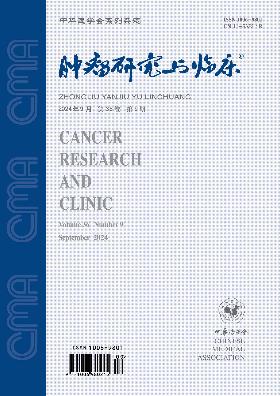噬菌体筛选的人髓质乳腺癌Bcap-37细胞特异性结合肽的体内展示及其性质及联合效应
Q4 Medicine
引用次数: 0
摘要
目的应用噬菌体展示技术研究肽与人癌症髓样细胞Bcap-37特异性结合的特性及其联合作用,为癌症的早期诊断提供分子靶向探针。方法制备人乳腺髓样癌Bcap-37细胞荷瘤裸鼠模型,利用Ph.D.C7CTM噬菌体展示肽库进行体内三轮实验。应用免疫组织化学方法检测筛选出的噬菌体在肿瘤和正常组织中的分布。单克隆噬菌体对Bcap-37细胞的亲和力通过酶联免疫吸附试验(ELISA)进行鉴定。对阳性的单克隆噬菌体DNA进行测序,选择重复率高的序列,用化学方法合成肽。制备了光学分子探针,并用荧光分子成像技术在体内检测其对荷瘤裸鼠乳腺移植瘤的特异性和靶向能力。结果第三轮体内筛选的噬菌体回收率是第一轮的107.2倍。免疫组化结果显示,随着体内筛选次数的增加,与肿瘤组织结合的噬菌体数量依次增加。与肿瘤组织结合的噬菌体数量多于与正常组织(肺、骨骼肌、肝和肾)结合的噬菌体。切片扫描图像在肿瘤组织中的吸光度(A)值高于正常组织,差异有统计学意义(P<0.05)。ELISA结果显示,在随机选择的50个单克隆噬菌体中,有22个噬菌体(亲和力≥2)呈阳性。对阳性单克隆噬菌体进行DNA测序分析,得到4个重复氨基酸序列。合成了重复率最高的异硫氰酸荧光素标记(FITC)-CPLNTRFC肽。Bcap-37细胞荷瘤裸鼠体内模型试验表明,FITC-CSPLNTRFC肽可在乳腺异种移植物组织中显著富集。结论应用噬菌体展示技术可在体内成功筛选出与人癌症髓样细胞Bcap-37特异性结合的CSPLNTRFC肽,这将有助于体外研究癌症的早期诊断。关键词:乳腺肿瘤;肽库;噬菌体展示;特异性结合肽本文章由计算机程序翻译,如有差异,请以英文原文为准。
Peptide specifically binding to human medullary breast carcinoma Bcap-37 cells selected by phage display in vivo and its property as well as combination effect
Objective
To investigate the property and the combination effect of the peptide specifically binding to human medullary breast cancer Bcap-37 cells by using phage display in vivo and to provide molecular targeting probe for early diagnosis of breast cancer.
Methods
The human medullary breast carcinoma Bcap-37 cells tumor-bearing nude mice model was prepared and three rounds in vivo were performed by using Ph.D.-C7CTM phage display peptide library. The distribution of screened phages in tumors and normal tissues was detected by using immunohistochemistry. The affinity of monoclonal phage to Bcap-37 cells was identified by using enzyme linked immunosorbent assay (ELISA). The positive monoclonal phage DNA was taken and sequenced, and the sequence with high repetition rate was selected to synthesize peptide by using chemical methods. Optical molecular probe was prepared and fluorescence molecular imaging was used to test its specificity and targeting ability for breast transplantation tumor of tumor-bearing nude mice in vivo.
Results
The recovery rate of phage in the third round screening in vivo was 107.2 times than that in the first round. Immunohistochemical results showed that the phages binding to the tumor tissues were increased successively with the increasing screening rounds in vivo. The number of phages binding to tumor tissues was more than that binding to normal tissues (lung, skeletal muscle, liver and kidney). The absorbancy (A) value of section scanning image in the tumor tissues was higher than that in the normal tissues, and the difference was statistically significant different (P < 0.05). ELISA results showed that 22 phages (affinity≥2) among the 50 randomly selected monoclonal phage were positive. After DNA sequencing analysis of the positive monoclonal phage, 4 repeat amino acid sequences were obtained. The fluorescein isothiocyanate-labelled (FITC)-CSPLNTRFC with the highest repetition rate was synthesized for FITC-CSPLNTRFC peptide. Bcap-37 cells tumor-bearing nude mice model assay in vivo showed that FITC-CSPLNTRFC peptide could significantly enriched in the breast xenograft tissues.
Conclusion
CSPLNTRFC peptide specifically binding to human medullary breast cancer Bcap-37 cells can be screened out successfully by using phage display in vivo, which will be helpful to vitro studies on the early diagnosis of breast cancer.
Key words:
Breast neoplasms; Peptide library; Phage display; Specifically binding peptide
求助全文
通过发布文献求助,成功后即可免费获取论文全文。
去求助
来源期刊

肿瘤研究与临床
Medicine-Oncology
CiteScore
0.10
自引率
0.00%
发文量
7737
期刊介绍:
"Cancer Research and Clinic" is a series of magazines of the Chinese Medical Association under the supervision of the National Health Commission and sponsored by the Chinese Medical Association.
It mainly reflects scientific research results and academic trends in the field of malignant tumors. The main columns include monographs, guidelines and consensus, standards and norms, treatises, short treatises, survey reports, reviews, clinical pathology (case) discussions, case reports, etc. The readers are middle- and senior-level medical staff engaged in basic research and clinical work on malignant tumors.
 求助内容:
求助内容: 应助结果提醒方式:
应助结果提醒方式:


